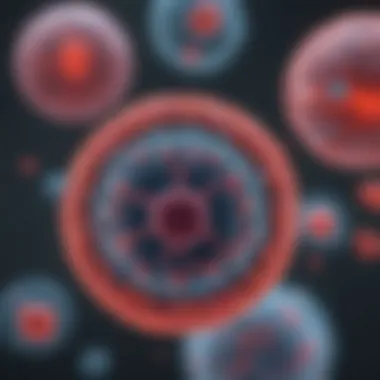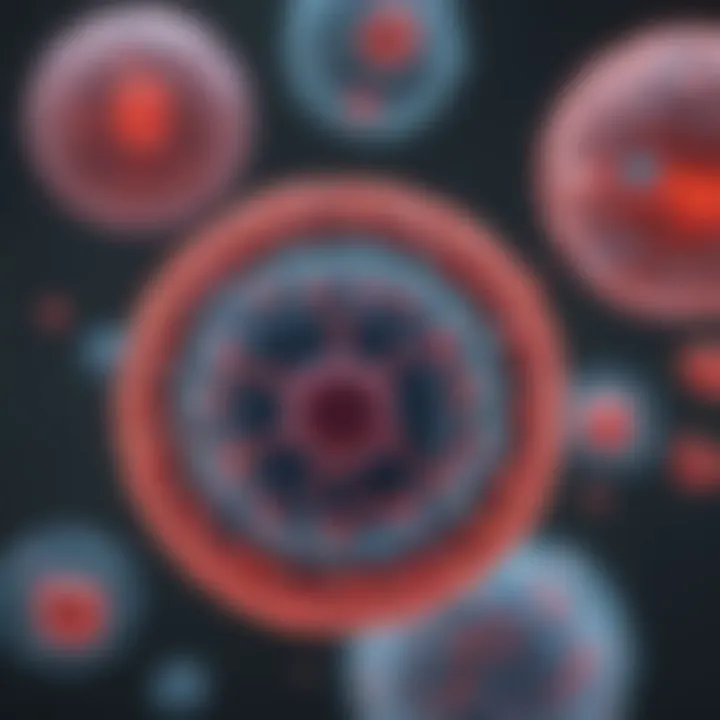Leukaemia Stem Cell Transplant: An In-Depth Analysis


Intro
Leukaemia is a form of cancer that affects blood cells, largely disrupting normal blood cell production. Stem cell transplant is one of the more complex and essential treatments for patients diagnosed with this disease. Understanding the intricacies of leukaemia stem cell transplant not only illuminates the treatment pathway but also enhances our insight into the biological mechanisms at play. This section sets the stage for a detailed investigation into the research surrounding stem cell transplantation for leukaemia.
Research Overview
Summary of Key Findings
Recent studies have established that leukaemia stem cells (LSCs) play a crucial role in the persistence and relapse of the disease. Research highlights the direct relationship between LSC characteristics and treatment outcomes. The understanding of these stem cells has led to innovative therapeutic approaches, including targeted immunotherapies and gene editing techniques. These key findings underscore the potential for improving patient outcomes through tailored approaches to transplant.
Importance of the Research
The significance of studying leukaemia stem cell transplants lies in its impact on patient care. As medical professionals delve deeper into the genotype and phenotype of leukaemia stem cells, they can enhance patient selection processes and minimize complications post-transplant. This ongoing research not only informs clinical practices but also helps in shaping future therapeutic strategies against this challenging disease.
Methodology
Study Design
The studies reviewed involve both retrospective and prospective analyses of patient data undergoing stem cell transplantation. These transition phases allow for a thorough understanding of patient responses and treatment efficacy across diverse populations.
Data Collection Techniques
Data collection encompasses various techniques, including:
- Clinical trials: Phase 1 to Phase 3 trials that assess safety and efficacy.
- Patient registries: Maintaining comprehensive databases that track long-term outcomes.
- Biological assays: Techniques assessing the characteristics of stem cells to understand their role better.
By utilizing these robust methodologies, researchers are laying the groundwork for innovations and improvements in leukaemia treatment options.
Foreword to Leukaemia
Leukaemia represents a significant challenge within the medical field, particularly in hematology. Its complexity stems from both its biological underpinnings and clinical manifestations. Understanding leukaemia is paramount for developing effective treatment strategies, including stem cell transplantation. This section serves as the foundation for comprehending how leukaemia affects the body and how stem cells play a crucial role in therapy.
Definition and Types of Leukaemia
Leukaemia is defined as a group of cancers that affect the blood and bone marrow. It arises from the uncontrolled growth of abnormal blood cells, leading to a variety of symptoms and health complications. There are several types of leukaemia, generally categorized based on how quickly the disease progresses and the type of cells involved. The main classifications include:
- Acute Leukaemia: This type progresses rapidly and requires immediate treatment. Both Acute Lymphoblastic Leukaemia (ALL) and Acute Myeloid Leukaemia (AML) fall into this category.
- Chronic Leukaemia: Chronic forms develop more slowly. Chronic Lymphocytic Leukaemia (CLL) and Chronic Myeloid Leukaemia (CML) are examples.
Each type presents unique challenges in diagnosis, treatment, and management. Recognizing these differences is vital for clinicians and researchers focusing on leukaemia.
Epidemiology and Risk Factors
Understanding the epidemiology of leukaemia is essential for identifying at-risk populations and crafting prevention strategies. Leukaemia affects people of all ages, but certain types are more prevalent in specific demographics. For instance, ALL is more common in children, while CLL is primarily seen in older adults.
Several risk factors have been identified:
- Genetic Predisposition: Family history of leukaemia can increase risk.
- Environmental Exposures: Chemical exposures, such as benzene, and previous chemotherapy treatment can contribute.
- Certain Medical Conditions: Disorders like Down syndrome have been linked with higher rates of leukaemia.
Epidemiological studies continue to shed light on these risk factors, emphasizing the need for tailored approaches in screening and prevention efforts.
Understanding Stem Cells
Stem cells are essential to the process of treating leukaemia through transplantation. They are remarkable cells with the unique ability to develop into many different cell types. Understanding their characteristics and functions is fundamental to grasping why stem cell transplants offer significant benefits for leukaemia patients.
Types of Stem Cells
There are several types of stem cells, each with distinct capabilities. The most relevant types in the context of leukaemia treatment include:
- Hematopoietic Stem Cells (HSCs): These are found in bone marrow and are responsible for producing all the blood cells, including red blood cells, white blood cells, and platelets. They are key players in the recovery of blood counts after a transplant.
- Mesenchymal Stem Cells (MSCs): These cells are also located in the bone marrow. They can differentiate into various cell types, including bone, cartilage, and fat cells. Their role in immune modulation and tissue repair makes them important in post-transplant recovery.
- Embryonic Stem Cells: Though they have significant potential, their use in leukaemia treatment is still mainly theoretical and heavily regulated due to ethical concerns.
- Induced Pluripotent Stem Cells (iPSCs): Derived from adult cells, these cells can be programmed to revert to an undifferentiated state. Their use is currently under investigation for various therapies but is not yet standard in leukaemia treatment.
Each type of stem cell has particular advantages and drawbacks. The choice of which stem cell type to use in treatment depends on the specific circumstances of the patient and the underlying leukaemia type.
The Role of Stem Cells in Hematopoiesis
Hematopoiesis is the process through which blood cells are formed. It primarily occurs in the bone marrow. Stem cells play a critical role in this complex biological process. Hematopoietic stem cells are the progenitors of all blood cell lines. They undergo a series of differentiation steps to produce the various blood cells needed to maintain healthy bodily functions.
In the context of leukaemia, where the normal hematopoiesis process is disrupted, stem cells can help restore this balance.
When a patient undergoes a stem cell transplant, the infused stem cells migrate to the bone marrow, where they settle and begin the process of hematopoiesis anew. This renewal is crucial for reestablishing normal blood cell production. Without the restoration of normal hematopoiesis, patients are vulnerable to severe anemia, infection, and increased bleeding risk.
Understanding stem cells and their role in hematopoiesis is vital for ensuring effective management of leukaemia through transplantation. It underscores the importance of careful patient selection and the implementation of tailored approaches to treatment.
Mechanisms of Leukaemia Development
Understanding the mechanisms behind leukaemia development is crucial for comprehending how stem cell transplantation can be effectively utilized as a treatment method. Leukaemia is characterized by an abnormal proliferation of blood cells, primarily affecting the bone marrow and blood. Recognizing these underlying mechanisms can help researchers and clinicians identify better treatment pathways and anticipate patient responses to various therapies. Factors involved in leukaemia pathogenesis can generally be classified into genetic factors and environmental influences, each contributing to the overall disease process.
Genetic Factors in Leukaemia
Genetic factors play a significant role in the initiation and progression of leukaemia. Some of the most notable mutations occur in genes responsible for cell regulation, division, and apoptosis. For instance, mutations in the TP53 gene often lead to a loss of its tumor suppressor functions. This gene is critical for maintaining genomic stability, and its dysfunction can lead to unchecked cell growth. Other mutations, such as those in the FLT3 and NPM1 genes, have been implicated in various leukaemia subtypes, particularly acute myeloid leukaemia (AML).
Chromosomal abnormalities also serve as vital indicators of leukaemia risk. For example, the presence of the Philadelphia chromosome is commonly associated with chronic myeloid leukaemia (CML). This abnormality results from a translocation between chromosomes 9 and 22, leading to the formation of the BCR-ABL fusion gene, which drives oncogenic signaling.
The interplay of these genetic mutations creates a complex landscape that defines the biology of leukaemia. It underscores the importance of personalized approaches in treatment, as different genetic profiles can significantly impact prognosis and response to therapies.
Environmental Influences
While genetic factors are paramount, environmental influences also play a crucial role in the development of leukaemia. Epidemiological studies have shown that certain exposures increase the risk of developing this disease. Factors such as ionizing radiation, certain chemicals, and viruses have been linked to leukaemia onset.


- Ionizing Radiation: Exposure to high levels of radiation, such as those from atomic bomb survivors, has been shown to elevate leukaemia risk. Healthcare workers exposed to diagnostic radiology also demonstrate a heightened risk compared to the general population.
- Chemical Exposures: Chemicals like benzene and certain chemotherapy drugs have been associated with increased risk. Benzene, commonly found in industrial settings and cigarette smoke, can cause genetic mutations associated with leukaemia.
- Viral Infections: Some viruses, including the Epstein-Barr virus (EBV) and Human T-lymphotropic virus type I (HTLV-I), have also been implicated in leukaemia development. These viruses can lead to genetic changes that promote malignant transformation in healthy cells.
The combination of these environmental influences with genetic predispositions emphasizes the need for careful monitoring and preventive measures in high-risk populations. Addressing both genetic and environmental factors is essential to creating effective strategies for leukaemia prevention and treatment.
"Understanding the mechanisms of leukaemia development helps shape therapeutic strategies aimed at targeting specific cellular pathways, improving patient outcomes in stem cell transplantation."
In summary, the mechanisms of leukaemia development, characterized by both genetic mutations and environmental influences, provide a comprehensive framework for understanding the disease's complexity. Insights from this understanding can lead to more targeted therapies tailored to individual patient needs.
The Rationale for Stem Cell Transplant in Leukaemia
Stem cell transplantation has become a cornerstone in the treatment of leukaemia, providing a potentially curative option for patients with this complex disease. The rationale behind its use lies in the unique properties of stem cells and the profound impact they can have on the treatment landscape of leukaemia. This section discusses the mechanisms through which stem cell transplants operate, as well as comparing their efficacy to other treatment methods.
Mechanism of Action
Stem cell transplants involve the infusion of stem cells into a patient's body, aiming to restore the damaged or diseased bone marrow. The primary mechanism of action is based on the ability of these stem cells to develop into healthy, functioning blood cells, including white blood cells, red blood cells, and platelets.
When patients undergo high-intensity chemotherapy or radiation treatment to eradicate leukaemia cells, they often experience destruction of their bone marrow. This is where stem cells come into play. The transplant serves two main purposes:
- Reconstitution of Stem Cell Population: The infused cells can repopulate the bone marrow, restoring its normal function.
- Immune Response: In the case of allogeneic transplants, donor cells can recognize remaining leukaemia cells as foreign and mount an immune response against them. This graft-versus-leukaemia effect can significantly contribute to the elimination of any residual cancer cells.
This dual action solidifies the role of stem cell transplantation as one of the most effective strategies in treating leukaemia, especially in high-risk patients who may not respond well to conventional therapies.
Comparative Efficacy of Treatments
When evaluating the various treatment options available for leukaemia, stem cell transplantation stands out for its potential to offer long-term remissions or even cure. The efficacy of stem cell transplants compared to traditional methods can be understood by examining several key factors:
- Long-Term Survival: Several studies show that patients undergoing stem cell transplants, particularly allogeneic transplants, have improved survival rates compared to those treated with chemotherapy alone. They are often seen as a viable option when other treatments have failed.
- Disease Relapse Rates: Stem cell transplants can reduce the likelihood of relapse. This is primarily because the infused immune cells from the donor can help to eliminate residual leukaemia cells—an effect which non-transplanted patients may lack after chemotherapy.
- Patient Population: The suitability of stem cell transplants depends on various elements, such as age, overall health, and specific type of leukaemia. Young, fit patients generally experience better outcomes post-transplant, making careful patient selection critical.
While stem cell transplantation is not a one-size-fits-all solution, its advantages in terms of survival and reduced relapse rates position it as a fundamental option in leukaemia treatment.
The rationale for choosing stem cell transplants is not only rooted in immediate treatment goals but also takes into account long-term remission and potential curative outcomes.
Preparation for Stem Cell Transplant
Preparing for a stem cell transplant is a critical step that influences the success of the procedure. This preparation phase goes beyond the mere procedural aspects; it encompasses a range of considerations and actions aimed at optimizing patient outcomes. The importance of this phase lies in its ability to set the stage for the transplant, addressing both the medical and psychological needs of the patient. Here, we explore two key components in this preparation phase: patient evaluation and selection, as well as pre-transplant conditioning regimens.
Patient Evaluation and Selection
The evaluation and selection of patients for stem cell transplant is paramount. Not every leukaemia patient is suitable for this complex procedure. Medical teams conduct thorough assessments to determine the candidacy of each patient.
Factors considered include:
- Overall Health: Patients must be evaluated for other health conditions that may complicate the transplant. Conditions such as heart disease or severe diabetes can be detrimental.
- Leukaemia Type and Stage: Different types of leukaemia respond differently to treatments. The type and stage will significantly impact the eligibility and expected outcomes of the transplant.
- Previous Treatments: Previous therapies can influence how well a patient will respond post-transplant. The types of treatments undergone play a crucial role.
- Age and Performance Status: Age can affect recovery, and performance status provides insights into the patient’s ability to tolerate the rigors of the procedure.
All these factors are synthesized to form a comprehensive view of a patient’s suitability. A multi-disciplinary team often contributes to this evaluation, ensuring no aspect is overlooked.
Pre-Transplant Conditioning Regimens
Once a patient is deemed suitable for a stem cell transplant, they must undergo pre-transplant conditioning regimens. This step is crucial as it prepares the patient’s body for the incoming stem cells. The conditioning regimen typically involves two components: chemotherapy and sometimes radiation therapy.
The purpose of these regimens include:
- Eradication of Malignant Cells: High-dose chemotherapy targets and eliminates residual leukaemia cells from the body. This increases the chances of a successful transplant.
- Suppression of Immune Response: These regimens aim to suppress the patient’s immune system. This reduction minimizes the risk of rejection of the transplanted stem cells.
However, the intensity and duration of these regimens must be carefully managed. The risks associated with conditioning regimens include:
- Infection: A suppressed immune system heightens the risk of infections during this phase.
- Organ Toxicity: High doses of chemotherapy and radiation can lead to damage of healthy organs.
The aim is to balance these risks with the potential benefits. Each patient’s regimen is tailored based on individual characteristics and medical history.
In summary, preparation for a stem cell transplant requires an in-depth understanding of patient needs and meticulous planning. Patient evaluation and tailored conditioning regimens work together to create the best possible outcomes for those undergoing what can be a life-saving procedure.
Types of Stem Cell Transplants
In the field of leukaemia treatment, understanding the types of stem cell transplants is essential for identifying the best therapeutic approach for patients. Stem cell transplants are categorized into two main types: autologous and allogeneic. Each type has its own set of benefits, challenges, and considerations that affect treatment outcomes and patient well-being.
Autologous Stem Cell Transplant
Autologous stem cell transplants involve the collection and reinfusion of a patient’s own stem cells. The procedure begins with mobilization, where stem cells are stimulated to enter the bloodstream. This might be achieved using growth factors like G-CSF or through chemotherapy. Once mobilized, blood is drawn and stem cells are collected using a process called apheresis.
The significant advantage of this method is that it minimizes the risk of graft-versus-host disease (GVHD), a common complication seen in transplant patients. Since the cells are derived from the patient, there is no foreign immune response to contend with. However, one must consider the potential limitations.
- Eligibility: Autologous transplants are mainly suitable for patients with a certain degree of remission and those who do not have significant damage to their own stem cell reserves due to previous treatments.
- Disease Recurrence: Since the cancerous cells can be present alongside the healthy stem cells, there remains a risk for disease recurrence post-transplant.
In summary, autologous stem cell transplants can be a viable option for selected patients, particularly those with certain subtypes of leukaemia who respond well to chemotherapeutic regimens before transplantation.
Allogeneic Stem Cell Transplant
Allogeneic stem cell transplants involve the use of stem cells sourced from a compatible donor, which can be a relative or an unrelated individual who matches the patient’s human leukocyte antigen (HLA) profiles. This type of transplant is particularly significant in treating leukaemia because it not only aims to eliminate cancer cells but also employs the donor’s immune cells to aid in the fight against the remaining malignant cells.
The advantages are prominent:
- Graft-versus-Leukaemia Effect: The immune response initiated by the donor's cells can help target and eradicate residual leukaemia cells, potentially reducing the chance of relapse.
- Stem Cell Reserves: For patients whose own cells are compromised due to previous treatments, allogeneic transplantation can provide a new supply of healthy stem cells.
However, several considerations need to be acknowledged:
- GVHD Risk: The introduction of foreign cells makes patients susceptible to graft-versus-host disease, where the donor immune cells attack the recipient’s tissues.
- Donor Compatibility: Identifying a suitable donor can be a lengthy process requiring extensive tissue typing and sometimes delaying treatment.


The Stem Cell Transplant Procedure
The stem cell transplant procedure is a crucial aspect of treating leukaemia. Understanding this process helps delineate the complexities associated with it. This process can significantly influence patient outcomes. It is divided into detailed steps, each vital to the overall success of the transplant. This section will spotlight these steps, alongside their significance and benefits.
Collection of Stem Cells
The initial step of the stem cell transplant procedure involves collecting stem cells. The source of these cells can be from the patient's own body or a compatible donor. When the stem cells are collected from the patient, it is termed autologous transplant. Conversely, if stem cells are sourced from another person, it is referred to as allogeneic transplant.
There are a few methods for collection:
- Peripheral Blood Stem Cell (PBSC) Collection: This method uses a machine to separate stem cells from blood drawn from the bloodstream. The remaining blood components are returned to the body.
- Bone Marrow Harvesting: This involves extracting stem cells directly from the bone marrow, usually from the hip bone.
- Cord Blood Collection: This approach entails collecting stem cells from umbilical cord blood after childbirth, providing an alternative source.
Proper collection techniques are vital. They ensure the quantity and quality of stem cells are adequate for the transplant. The entire process is carefully monitored, as it can lead to side effects like fatigue or discomfort. Nonetheless, it is a fundamental step in preparing for the stem cell transplant.
Transplant Process Overview
Following successful stem cell collection, the next component is the transplant process itself. This process starts with the conditioning regimen, which may include chemotherapy or radiation. The purpose is to eliminate as many leukaemia cells as possible and prepare the body for new stem cells.
The actual transplant occurs in a hospital setting, where the collected stem cells are infused into the patient through an intravenous line. This infusion usually does not cause pain, resembling a blood transfusion. Once administered, the stem cells travel to the bone marrow, where they begin establishing themselves. The time taken for the new stem cells to engraft varies but is crucial for recovery.
It is important to consider that the transplant process is not a standalone event. Intensive post-transplant care is needed to monitor recovery and manage possible complications. One should also be aware that individual responses to the transplant can differ, often depending on the patient’s general health and the type of leukaemia being treated.
The successful completion of a stem cell transplant can lead to remission but requires meticulous planning and execution throughout the procedure.
In summary, the stem cell transplant procedure incorporates the collection of stem cells and the actual transplant. Both steps demand detailed understanding and precision, as they play integral roles in the potential for positive outcomes in leukaemia treatment.
Post-Transplant Care
Post-transplant care is a crucial phase in the treatment of patients who have undergone stem cell transplants for leukaemia. This stage focuses on monitoring the patient's recovery, preventing complications, and promoting overall well-being. Effective post-transplant care can significantly affect patient outcomes and quality of life. Understanding the elements involved in post-transplant care allows healthcare providers to offer comprehensive support to patients and their families.
Monitoring for Complications
Monitoring for complications is an essential aspect of post-transplant care. Patients who receive stem cell transplants are at risk of various complications, including infections, graft-versus-host disease (GVHD), and organ dysfunction. Continuous observation is crucial during the early months following the transplant, as this is when most complications arise.
- Infection Risks: Patients often experience a weakened immune system, making them more susceptible to infections. Healthcare teams must monitor for signs of infection, such as fever or unusual fatigue. Regular blood tests can help detect infections early.
- Graft-versus-Host Disease (GVHD): GVHD is a condition where donor cells attack the recipient's tissues. It can be acute or chronic and requires careful monitoring and management. Symptoms may include skin rashes, liver dysfunction, and gastrointestinal issues. Early detection is key to managing GVHD effectively.
- Organ Function Assessment: Routine evaluations of organ function, especially liver and kidney function, are necessary. Monitoring helps in identifying any early signs of organ issues, allowing timely intervention.
"Effective monitoring and prompt management of complications can greatly enhance patient outcomes post-transplant."
In addition to physical assessments, emotional and psychological monitoring is also vital. Patients may experience anxiety and depression during recovery, which can affect adherence to medical regimens and overall health.
Rehabilitation and Support Services
Rehabilitation and support services play a significant role in the post-transplant journey. They encompass a wide range of resources aimed at helping patients regain their strength, improve their quality of life, and manage the aftereffects of treatment.
- Physical Rehabilitation: This includes tailored exercise programs designed to rebuild strength and endurance. Engaging in physical activity can help combat fatigue, improve mobility, and enhance overall physical health.
- Psychological Support: Counseling and support groups are vital for addressing the emotional challenges that accompany the recovery process. Connecting with peers who have undergone similar experiences can provide insights and reassurance.
- Nutritional Support: Proper nutrition is essential for recovery. Dietitians can assist in creating meal plans that meet the unique nutritional needs of transplant patients, promoting healing and preventing weight loss.
- Social Services: Access to social services can aid in navigating insurance issues, financial concerns, and other logistical challenges that may arise post-transplant. These resources help alleviate stress, allowing patients to focus on their recovery.
Rehabilitation and support services not only facilitate physical recovery but also foster emotional resilience. The integration of these services contributes to a holistic approach to care that acknowledges the multifaceted nature of recovery after a stem cell transplant.
Potential Complications of Stem Cell Transplant
The discussion of Potential Complications of Stem Cell Transplant is crucial in the overall examination of leukaemia treatment methodologies. While stem cell transplants can provide significant benefits in managing leukaemia, they also come with risks that can have profound implications for patients. Understanding these complications is vital for both healthcare providers and patients, enabling better preparation and management strategies.
Patients undergoing stem cell transplants are often in a vulnerable state, balancing the potential for recovery against possible adverse effects. Comprehensive education on these risks can help in making informed decisions and in setting realistic expectations regarding the transplant process.
Graft-versus-Host Disease (GVHD)
Graft-versus-Host Disease, commonly referred to as GVHD, is one of the most significant complications following allogeneic stem cell transplants. This condition arises when the transplanted immune cells from the donor recognize the recipient's body tissues as foreign and attack them.
Symptoms of GVHD can range from mild to severe and may include:
- Skin rashes and itching
- Diarrhea
- Liver dysfunction
The severity of GVHD can vary considerably. Acute GVHD typically occurs within the first 100 days post-transplant, while chronic GVHD may persist for months or years. The management of GVHD involves systemic treatments and careful monitoring by healthcare professionals.
Prevention Strategies
To minimize the incidence and severity of GVHD, several pre-emptive measures can be taken.
- Selecting a closely matched donor can significantly reduce risks.
- Immune suppression therapies post-transplant are commonly used to prevent GVHD from developing.
"Preventive strategies are vital. Understanding donor-recipient compatibility can make a significant difference."
Infections and Other Risks
Infections are another major concern for patients undergoing stem cell transplantation. This is due to the immunocompromised state the patients experience following the procedure.
Both bacterial and viral infections can pose serious threats. Common infections may include:
- Pneumonia
- Septicemia
- Viral reactivations such as cytomegalovirus (CMV)
The neutropenic phase, characterized by a low white blood cell count, typically occurs in the early days post-transplant. This phase requires meticulous care as even common pathogens can become life-threatening during this period.
Infection Prevention Measures
To counter these risks, healthcare teams engage in several infection prevention practices:
- Administering prophylactic antibiotics and antivirals
- Maintaining strict hygienic measures in hospital settings
- Regular monitoring for early signs of infections


Long-Term Outcomes and Follow-Up
Long-term outcomes and follow-up after a stem cell transplant for leukaemia are critical components of the treatment process. The decision to undergo such a substantial intervention requires careful consideration of the potential long-term effects on both survival and quality of life. This section delves into the survival rates classified by leukaemia type and the post-transplant quality of life, both vital for understanding the efficacy of stem cell transplants as a treatment option.
Survival Rates by Leukaemia Type
Survival rates following stem cell transplantation vary considerably based on the type of leukaemia diagnosed.
- Acute Lymphoblastic Leukaemia (ALL): With aggressive treatment, especially in younger patients, five-year survival rates can reach over 60-70%. Continuous advancements in therapies contribute to this increase.
- Acute Myeloid Leukaemia (AML): The survival rates for AML differ widely and generally range around 30-50%. Several factors influence these rates, including the patient's age and genetic mutations.
- Chronic Lymphocytic Leukaemia (CLL): For patients undergoing allogeneic transplantation, the five-year survival can be about 40-70%, depending on disease stage and other health conditions at the time of treatment.
- Chronic Myeloid Leukaemia (CML): Patients can expect better outcomes with a five-year survival estimate close to 70-90%, particularly with advancements in targeted therapies leading up to the transplant.
These statistics underline a crucial aspect of treatment, as patients and healthcare providers must keep in mind that these figures represent averages. Individual outcomes can substantially differ based on unique patient circumstances. Regular follow-up care, including monitoring potential relapses, is essential, especially as patients transition from intense treatment to recovery.
Quality of Life Post-Transplant
Evaluating quality of life after a stem cell transplant offers significant insight into the patient's overall recovery experience. Patients may face various challenges, but they often report an improved quality of life long-term when compared to the pre-transplant phase.
- Physical Health: Many patients experience fatigue and weakness post-transplant, but most regain strength over time. Regular physical therapy and gradual engagement in physical activities are encouraged.
- Mental and Emotional Well-Being: Psychological support is vital. Patients often deal with anxiety and depression following hospitalization. Access to counseling and support groups can aid emotional recovery significantly.
- Social Life and Relationships: The transplant process can strain relationships; however, many patients find renewed appreciation for relationships and engage more deeply with family and friends after recovery.
- Long-Term Side Effects: It is vital for patients to be aware of long-term side effects, including potential organ damage or infertility. Healthcare providers should discuss these risks upfront.
"Regular check-ups and comprehensive follow-ups play a key role in monitoring both physical health and emotional adjustments post-transplant."
In summary, both survival rates and quality of life after stem cell transplant are critical aspects that define the treatment's success in leukaemia cases. Understanding these elements helps equip patients and healthcare providers with the necessary insights for effective management and support throughout the recovery journey.
Advancements in Research
Research in leukaemia stem cell transplant is critical for enhancing treatment efficacy and improving patient outcomes. This area of study not only addresses current limitations in therapies, but also opens pathways to innovative methods that can potentially redefine patient care. Understanding recent advancements equips patients, healthcare professionals, and researchers with essential knowledge and hope.
Innovative Therapeutic Approaches
Recent studies have focused on various innovative therapeutic approaches that aim to improve the success rates of leukaemia stem cell transplants. These include novel drug formulations, targeted therapies, and immune-based strategies.
- CAR T-cell Therapy: Chimeric Antigen Receptor (CAR) T-cell therapy has shown promise in treating certain types of leukaemia. This method involves modifying a patient’s T-cells to enhance their capacity to target and destroy cancer cells, offering an alternative or adjunct to traditional stem cell transplants.
- Gene Editing: Techniques like CRISPR are being explored to modify stem cells genetically before transplant, enhancing their ability to thrive in the host.
- Targeted Monoclonal Antibodies: These antibodies can specifically target leukaemia cells while sparing normal cells. Such precision reduces the overall toxicity of treatments and highlights a shift toward personalized medicine.
Every new approach offers unique benefits but also faces challenges. For example, the effectiveness and safety of these therapies must be established through rigorous clinical trials, which can take time.
Future Directions in Stem Cell Research
Looking ahead, future directions in stem cell research indicate a strong focus on improving outcomes and minimizing risks associated with transplant procedures.
- Exploring Niche Cells: Understanding how the stem cell niche influences stem cell behavior post-transplant could enhance engraftment success. Knowledge of these interactions may uncover strategies to optimize the conditions under which stem cells operate in the recipient.
- Immunotherapy Integration: The integration of immunotherapeutic agents with traditional transplant procedures represents a promising frontier. Investigating how these therapies can work synergistically with stem cells may lead to breakthroughs in managing recurrence rates.
- Longitudinal Studies: There is a growing emphasis on conducting long-term follow-up studies to monitor how patients fare years after their transplants. This data is crucial for recognizing the late-onset effects of both leukaemia and its treatment.
- Regenerative Medicine: Investigating the application of stem cells in regenerative medicine continues to gain attention. Insights could extend beyond leukaemia treatment, offering potential therapies for other hematological conditions.
"The future of leukaemia treatment lies in understanding not just the disease, but how to tailor therapies to the unique needs of each patient."
As these avenues of research progress, they promise to evolve the landscape of leukaemia treatments significantly. Collaboration among researchers, clinicians, and patients will remain vital to achieving these advancements.
Ethical Considerations
Ethics plays a critical role in the context of leukaemia stem cell transplant. This area of medicine raises various dilemmas that need careful thought. Understanding these ethical considerations is essential for making informed decisions in patient care and advancing research in the field.
Several elements emerge in this discussion:
- The sourcing of stem cells: Stem cells can be obtained from various sources, including embryos and adult tissues. The ethical implications involved in these sources significantly influence public opinion and policy.
- Equal access to treatments: Equity in healthcare is a pressing concern. Decisions regarding the allocation of resources for stem cell transplants can affect who benefits from these advancements. Socioeconomic factors should not decide who has access to life-saving treatments.
- Long-term consequences: Ethical considerations also encompass the long-term effects of stem cell transplants on patients. Understanding the risks involved and the ethical implications of potentially altering human biology is vital.
"The intersection of ethics and stem cell research poses profound questions, often challenging the norms and values of society."
These issues reflect the complex landscape that surrounds stem cell transplantation in leukaemia, necessitating ongoing dialogue between healthcare providers, ethicists, and the community.
Ethics of Stem Cell Use
The ethical use of stem cells is a multidimensional debate. On one side are advocates who emphasize potential benefits for treating leukaemia and other conditions. On the other side are opponents who raise concerns about the moral implications tied to using certain types of stem cells, particularly those derived from embryos.
Key considerations include:
- Moral status of embryos: The debate often revolves around the moral status of embryos and their rights. Some argue that embryos should not be used for research, while others believe that the potential benefits for patients justify this use.
- Tissue donation: The ethical acquisition of adult stem cells requires informed consent from donors. Patients’ autonomy must be respected, ensuring that they understand the implications of their choices, including the potential risks and benefits of donation.
- Research ethics: Any research involving stem cells requires adherence to strict ethical guidelines. These ensure that research is conducted responsibly and that the rights of participants are protected.
As medical advances develop, it remains crucial to evaluate the ethical framework guiding their application.
Patient Consent and Autonomy
Patient consent is a cornerstone of ethical medical practice, particularly in the context of stem cell transplants. This process involves respecting a patient’s right to make informed decisions about their treatment. The complexities of stem cell therapy necessitate a thorough understanding by patients of what is involved.
Critical aspects include:
- Informed consent: Patients must be fully informed about the procedures, risks, benefits, and alternatives before consenting to stem cell transplants. This empowers them to make decisions that align with their values and circumstances.
- Autonomy: Respecting a patient’s autonomy is essential for ethical practice. Healthcare providers must take into account individual beliefs regarding treatment options. This may influence whether a patient chooses to undergo a transplant or to opt for alternative therapies.
- Communication: Open dialogue between healthcare providers and patients fosters trust. Providers should take the time to ensure that patients understand all facets of the transplant process, enabling them to give informed consent. This communication is critical to promoting patient autonomy in decision-making.
Overall, the principles of ethical stem cell use and patient consent demand careful consideration. They are essential for the integrity of the transplant process and the well-being of those affected by leukaemia.
End
The conclusion serves as a vital component of any discussion regarding leukaemia stem cell transplantation. It synthesizes the information presented, underscoring the complexity and critical importance of the topic in modern hematology. This rounded overview brings to light how stem cell transplants serve not only to treat leukaemia but also to enhance the quality of patient care and outcomes.
Summary of Key Points
In reviewing our exploration of leukaemia stem cell transplantation, several key points stand out:
- Mechanisms of Treatment: Stem cell transplants can restore hematopoiesis, facilitating recovery from leukaemia treatments like chemotherapy. This regenerative capacity underpins much of their clinical utility.
- Patient Criteria: Proper patient selection is paramount. Only candidates without substantial comorbidities and with favorable disease characteristics are chosen for this intensive therapy.
- Complication Awareness: Awareness of potential complications, particularly graft-versus-host disease and infection risks, cannot be overstated. Monitoring and management strategies are indispensable in post-transplant care.
- Research Directions: Ongoing research is essential to improve methodologies, reduce complications, and enhance long-term outcomes for patients.
This summary encapsulates the major findings and considerations that inform both clinical practice and future research efforts in leukaemia treatment.
The Future of Leukaemia Treatment
Looking ahead, the future of leukaemia treatment, especially regarding stem cell transplantation, appears promising yet challenging. Innovations in technology, such as gene editing and improved transplant protocols, hold potential to substantially affect outcomes.
- Cellular Engineering: Developments in genetically engineered cells may lead to more effective engraftment and minimization of adverse effects. Research in personalized medicine will continue to refine treatment pathways.
- Enhanced Support Protocols: Advancements in supportive care can reduce the risk of post-transplant complications, enabling more patients to benefit from these life-saving procedures. Comprehensive care approaches are vital for quality of life post-transplant.
- Collaboration and Research: Collaboration among institutions and ongoing research will create platforms for sharing knowledge and improving practices. Engaging a broader scientific community will expedite advancements in treatment.
The trajectory of stem cell transplantation in leukaemia treatment will continue to evolve, driven by research, clinical best practices, and an enhanced understanding of disease mechanisms.



